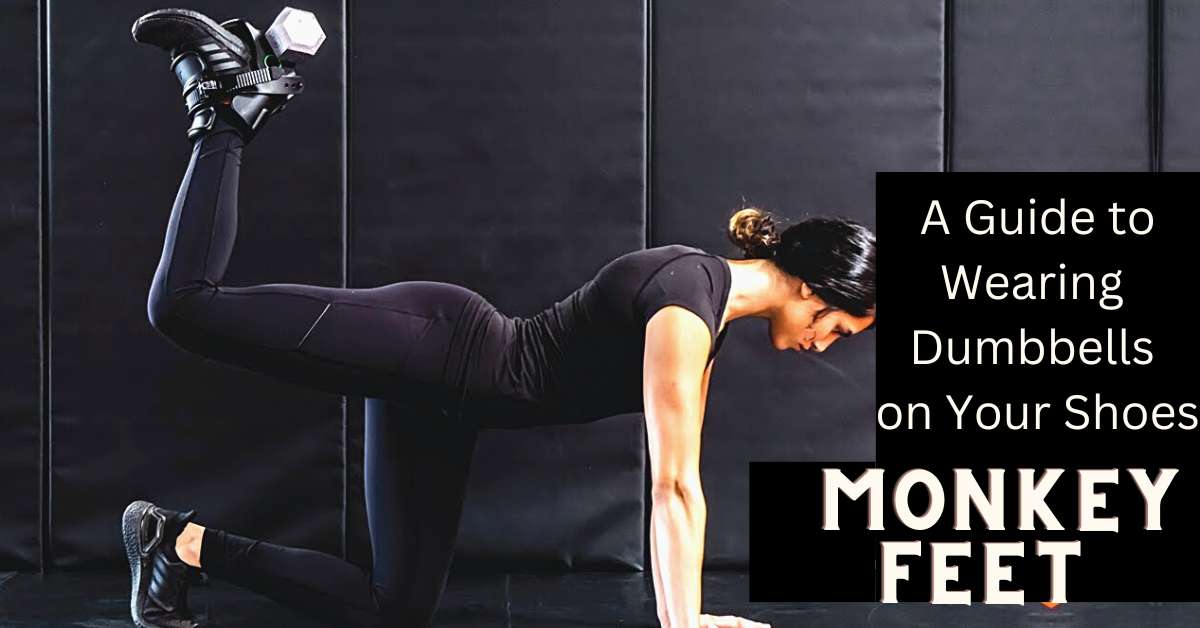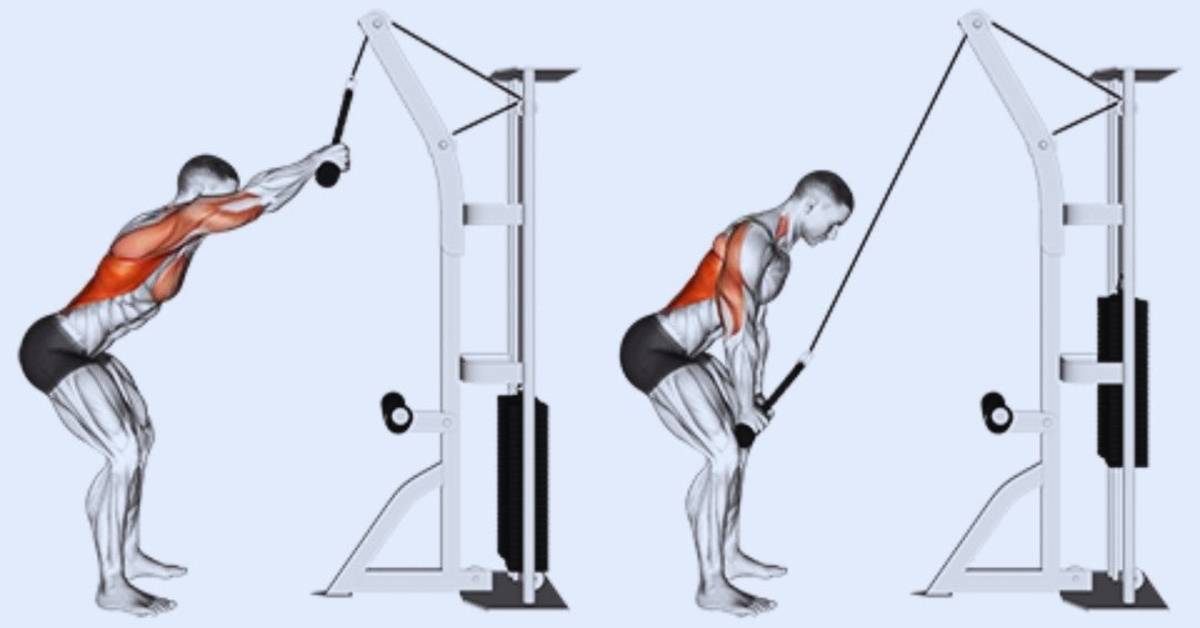Are you looking to build stronger hamstrings and glutes? Are you tired of endless squats, but still wanted to strengthen your lower back? Then try a dumbbell stiff leg deadlift! This powerful exercise is perfect for activating all the big muscles in your back while providing stability and support to your spine. It’s an excellent addition to any strength training routine, helping release tension in tight hips. With proper technique and focus on form, you can make this move safely from home or in the gym with just one pair of dumbbells!
Keep reading for step-by-step instructions on how to correctly perform the stiff leg deadlift with dumbbells, variations and modifications, essential tips, and mistakes.
Dumbbell Stiff Leg Deadlift Muscles Worked
The dumbbell stiff-leg deadlift is a popular exercise that targets several muscle groups in your lower body and posterior chain. This compound exercise primarily focuses on the hamstrings, glutes, and lower back.
Hamstrings
The hamstrings are a group of three muscles located at the back of your thigh: the biceps femoris, semitendinosus, and semimembranosus. The dumbbell stiff-leg deadlift is highly effective in targeting and strengthening these muscles. As you hinge at the hips and lower the dumbbells toward the ground, your hamstrings work to control the movement and extend your hips back to the starting position. Strong hamstrings contribute to better overall leg strength, stability, and athletic performance.
Glutes
The gluteal muscles, including the gluteus maximus, medius, and minimus, play a significant role in the dumbbell stiff-leg deadlift. These muscles are engaged as you push your hips back, creating tension and activation in the gluteal region. The controlled movement of lifting the dumbbells upward relies on the gluteal muscles to extend the hips and bring your body back to a standing position. Developing strong glutes enhances your ability to generate power, improves hip stability, and contributes to well-rounded lower body strength.
Lower Back
While primarily targeting the hamstrings and glutes, the dumbbell stiff-leg deadlift also engages the muscles in your lower back. As you perform the exercise, your lower back muscles, including the erector spinae, work isometrically to stabilize your spine and maintain a neutral posture. This is crucial for maintaining proper form and preventing injury during the movement. Regularly incorporating the dumbbell stiff-leg deadlift into your routine can help strengthen and support your lower back muscles, leading to improved spinal stability and reducing the risk of lower back pain.
Erector Spinae
The erector spinae muscles are located along the spine and are responsible for extending and maintaining the posture of the vertebral column. During the dumbbell stiff-leg deadlift, the erector spinae muscles work isometrically to stabilize the spine and maintain a neutral position throughout the movement. Although the primary focus is on the hamstrings, glutes, and lower back, the erector spinae muscles play a supportive role in maintaining proper form and spinal alignment.
Latissimus Dorsi
The latissimus dorsi, commonly referred to as the lats, are large muscles located in the back that contribute to various pulling movements. While the dumbbell stiff-leg deadlift primarily targets the posterior chain muscles like the hamstrings, glutes, and lower back, the latissimus dorsi muscles are indirectly involved as stabilizers during the exercise. As you lift and lower the dumbbells, the lats help stabilize the shoulders and upper body, ensuring proper alignment and control.
Although the dumbbell stiff-leg deadlift is not considered a primary exercise for targeting the erector spinae and latissimus dorsi muscles, their engagement as stabilizers can provide some benefits in terms of spinal stability and upper body control. However, if your primary goal is to specifically target and strengthen these muscles, it would be more effective to incorporate exercises that directly isolate and engage them, such as rows, pull-ups, or specific lower back exercises.
Must Read: Smith Machine Good Mornings Exercise for Glutes, Hamstrings
How to do Stiff Legged Deadlifts with Dumbbells?
1. Start by standing with your feet hip-width apart, holding dumbbells in each hand. Keep your arms straight and palms facing the sides of your body.
2. Bend at the waist while maintaining a straight back and pushing your hips back as you lower the dumbbells toward the floor. As you descend, keep your chest up, gaze forward, and your shoulders back.
3. Once you reach the bottom position, pause for a few seconds and squeeze your glutes before pushing your hips forward and returning to the starting position.
4. Aim for 3-4 sets of 8-12 reps, and remember to maintain a light hold on the dumbbells and keep your back flat throughout the exercise.
Important Tips While Performing Stiff-Leg Deadlifts with Dumbbells
Here are some important tips to keep in mind while performing the dumbbell stiff-leg deadlift:
Warm Up Properly
Before starting any exercise, including the dumbbell stiff-leg deadlift, it’s crucial to warm up your muscles and increase your body’s core temperature. This can be achieved through dynamic movements such as jogging, jumping jacks, or hip swings. Warming up prepares your muscles for the upcoming workout and reduces the risk of injury.
Choose the Right Dumbbells
Selecting the appropriate dumbbell weight is essential. It should be challenging enough to stimulate your muscles but not so heavy that it compromises your form. Start with lighter weights and gradually increase the load as you gain strength and confidence in the movement.
Focus on Balance and Stability
Maintain a balanced stance throughout the exercise by distributing your weight evenly between both feet. Engage your core muscles to improve stability and prevent any excessive shifting or swaying as you perform the movement.
Keep the Dumbbells Close to Your Body
Throughout the exercise, make sure the dumbbells remain close to your body. Avoid letting them drift away or swing, as this can strain your lower back and reduce the effectiveness of the exercise. Maintain control by keeping the dumbbells in line with your legs throughout the entire range of motion.
Gradually Increase the Range of Motion
If you’re new to the dumbbell stiff-leg deadlift or have limited flexibility, start with a shorter range of motion. As you become more comfortable and flexible, gradually increase the depth of your descent, allowing for a deeper stretch in your hamstrings. However, never sacrifice form for a greater range of motion. Only go as far as you can while maintaining proper technique.
Engage Your Glutes
To maximize the activation of your glute muscles, consciously squeeze your glutes as you return to the starting position. This will help you achieve a stronger contraction and enhance the effectiveness of the exercise for your posterior chain.
Avoid Locking Your Knees
As you perform the movement, make sure that your knees are slightly bent throughout the entire movement. Avoid fully locking your knees at the top of the exercise, as this can put unnecessary stress on the joint. Keeping a soft bend in your knees helps to protect your knees and maintain proper muscle engagement.
Perform the Exercise with Control
Emphasize a controlled and deliberate movement throughout the entire exercise. Avoid using momentum to lift the dumbbells or jerking the weight upward. By performing the movement slowly and in a controlled manner, you engage the targeted muscles more effectively and reduce the risk of injury.
Listen to Your Body
Keep an eye on how your body feels during the exercise. If you experience any sharp or excessive discomfort, adjust your form or reduce the weight being lifted. It’s important to work within your limits and not push beyond what your body can safely handle.
Practice Consistency
Consistency is key to achieving progress and reaping the benefits of the dumbbell stiff-leg deadlift. Aim to incorporate this exercise into your regular workout routine to develop strength, improve flexibility, and promote muscle growth. Over time, you’ll notice improvements in your form, strength, and overall fitness level.
Read Also: How Long is a 3km Walk? (Time Revealed)
Mistakes to Avoid While Performing DB Stiff Leg Deadlift
There are some common mistakes to avoid when you are performing the dumbbell stiff-leg deadlift with dumbbells:
Rounded Back or Poor Posture
Maintaining proper posture is crucial during the dumbbell stiff-leg deadlift. Avoid rounding your back or allowing your shoulders to hunch forward. Instead, keep your spine straight, shoulders back, and chest lifted throughout the entire movement. To maintain a neutral spine position, you should engage your core muscles so that you can support your lower back.
Excessive Forward Lean
One common mistake is leaning too far forward during the descent, which places excessive stress on the lower back and diminishes the engagement of the targeted muscles. Instead, hinge at your hips while maintaining a slight bend in your knees, allowing your torso to lower toward the floor while keeping your back straight. Focus on feeling the stretch in your hamstrings rather than relying on the forward lean.
Using Excessive Weight
There is a risk of injury if you use weights that are too heavy because they will compromise your form and cause injury. Start with lighter dumbbells and gradually progress to heavier weights as you build strength and perfect your technique. It’s important to prioritize proper form and control over the amount of weight lifted.
Allowing the Dumbbells to Drift Away
One common error is allowing the dumbbells to move away from your legs as you lower them. This can strain your lower back and reduce the effectiveness of the exercise. Keep the dumbbells as close to your legs as possible throughout the entire movement, maintaining control and alignment.
Jerking or Using Momentum
It is important to avoid the use of momentum or jerking motions while lifting the dumbbells. This not only diminishes the effectiveness of the exercise but also increases the risk of injury. Instead, focus on a slow and controlled movement, emphasizing the engagement of your muscles throughout the entire range of motion.
Neglecting the Glute Squeeze
The glute squeeze at the top of the movement is an essential part of the dumbbell stiff-leg deadlift. Neglecting to squeeze your glutes can limit the activation of your posterior chain muscles. Focus on contracting your glutes forcefully at the top of the exercise to enhance the effectiveness of the movement.
Overarching the Lower Back
Avoid hyperextending or over-arching your lower back at the top of the movement. While it’s important to engage your glutes, aim for a neutral position of the spine. Excessive arching can strain your lower back and compromise your form.
Lifting Too Quickly
Performing the exercise too quickly can lead to loss of control and compromise your form. Maintain a slow and controlled tempo throughout the movement, emphasizing the stretch in your hamstrings and the activation of your glutes and core muscles.
Neglecting to Warm Up
It is important to make sure that you warm up properly before exercising in order to avoid injury. Before performing the dumbbell stiff-leg deadlift, ensure you warm up your muscles with dynamic movements such as jogging, jumping jacks, or hip swings. This helps to increase blood flow, improve flexibility, and prepare your body for the exercise.
Dumbbell Stiff-Leg Deadlift Variations
Here are some details on different variations of the dumbbell stiff-leg deadlift that you can try:
Single-Leg Dumbbell Stiff-Leg Deadlift
This variation adds an element of balance and stability to the exercise by focusing on one leg at a time. Stand on one leg while holding a dumbbell in the opposite hand, and hinge forward at the hips while keeping your back straight. Extend your free leg behind you for balance. This variation increases the demands on your core, glutes, and hamstrings while improving single-leg strength and stability.
Romanian Deadlift with Dumbbells
The Romanian deadlift (RDL) is a slight variation of the traditional stiff-leg deadlift. Instead of starting from a dead stop, the RDL involves a slight knee bend and a greater emphasis on the hip hinge. Hold the dumbbells with an overhand grip, slightly bend your knees, hinge at your hips, and lower the weights while maintaining a neutral spine. The RDL variation targets the hamstrings, glutes, and lower back while placing less stress on the knees.
Sumo Dumbbell Stiff-Leg Deadlift
The sumo deadlift variation involves taking a wider stance with your feet and turning your toes out at an angle. Hold the dumbbells with an overhand grip between your legs and hinge at your hips while maintaining a neutral spine. This variation places greater emphasis on the inner thighs (adductors) and glutes while still engaging the hamstrings and lower back muscles.
Deficit Dumbbell Stiff-Leg Deadlift
For this variation, you’ll need an elevated platform or step. Stand on the platform with your heels hanging off the edge, holding the dumbbells with an overhand grip. From this deficit position, hinge at your hips and lower the dumbbells while maintaining a neutral spine. The deficit dumbbell stiff-leg deadlift increases the range of motion and places greater emphasis on the hamstrings and glutes.
Dumbbell Stiff-Leg Deadlift with Row
This variation combines the benefits of the stiff-leg deadlift with an additional upper body exercise. Hold the dumbbells with an overhand grip and perform a stiff-leg deadlift as usual. However, as you return to the starting position, pull the dumbbells upward, bending your elbows and squeezing your shoulder blades together for a rowing motion. This variation targets the hamstrings, glutes, lower back, and upper back muscles.
Dumbbell Stiff-Leg Deadlift with Calf Raise
Incorporating a calf raise into the movement adds an extra challenge for the lower leg muscles. After performing the stiff-leg deadlift, as you return to the starting position, rise up onto the balls of your feet to perform a calf raise. This variation targets the hamstrings, glutes, lower back, and calves.
Dumbbell Stiff-Leg Deadlift with Reverse Fly
This variation combines the benefits of the stiff-leg deadlift with an exercise that targets the rear deltoids and upper back muscles. Hold the dumbbells with an overhand grip and perform a stiff-leg deadlift. As you return to the starting position, raise your arms out to the sides, squeezing your shoulder blades together for a reverse fly motion. This variation engages the hamstrings, glutes, lower back, and upper back muscles.
Dumbbell Stiff-Leg Deadlift Alternatives
Barbell Deadlift
The barbell deadlift is a compound exercise that targets multiple muscle groups, including the hamstrings, glutes, lower back, and core. It involves lifting a loaded barbell from the floor while maintaining a neutral spine and proper form. The barbell deadlift allows for greater loading potential and overall strength development compared to the dumbbell stiff-leg deadlift.
Kettlebell Swing
The kettlebell swing is a dynamic exercise that primarily targets the posterior chain, including the hamstrings, glutes, and lower back. It involves swinging a kettlebell between the legs and explosively driving the hips forward to propel the kettlebell forward. The kettlebell swing provides similar benefits to the stiff-leg deadlift while also improving power and explosiveness.
Glute Bridge
The glute bridge is a bodyweight exercise that primarily targets the glutes and hamstrings. Lie on your back with your knees bent and feet flat on the ground. Squeeze your glutes at the top of the movement as you lift your hips off the ground, and then lower them back down again. The glute bridge is an effective alternative for individuals who may not have access to weights or prefer a bodyweight exercise.
Good Mornings
Good mornings are performed with a barbell placed across the back of the shoulders. Stand with your feet shoulder-width apart, hinge at the hips while keeping your back straight, and lower your torso until parallel to the ground. This exercise targets the hamstrings, glutes, and lower back, similar to the stiff-leg deadlift.
Cable Pull-Through
The cable pull-through is a cable machine exercise that targets the posterior chain. Set the cable machine at a low setting, face away from the machine, and hold the handle between your legs. Hinge at the hips, keep your back straight, and push your hips forward, extending your body upright. The cable pull-through activates the hamstrings, glutes, and lower back while providing constant tension throughout the movement.
These exercises offer alternatives to the dumbbell stiff-leg deadlift, allowing you to target similar muscle groups and achieve similar benefits. Incorporating these variations into your workout routine can add variety, prevent plateaus, and cater to individual preferences and needs.
FAQs
Is the dumbbell stiff-leg deadlift suitable for beginners?
Yes, the dumbbell stiff-leg deadlift can be performed by beginners; however, it is important to start with lighter weights and focus on proper form before gradually increasing the intensity. Beginners may benefit from seeking guidance from a fitness professional to ensure correct execution.
Can I use other equipment instead of dumbbells?
Yes, if dumbbells are not available, you can use other equipment such as kettlebells, a barbell, or resistance bands to perform the stiff-leg deadlift. The choice of equipment depends on your preference and availability.
How many sets and repetitions should I do?
The number of sets and repetitions can vary depending on your fitness level, goals, and overall workout routine. It is recommended to start with 2-3 sets of 8-12 repetitions and adjust the volume as needed.
Should I keep my knees completely straight during the exercise?
While the term “stiff-leg” suggests keeping the knees straight, it is generally advised to maintain a slight bend in the knees to avoid placing excessive strain on the joints. Keeping a slight bend allows for better control and reduces the risk of injury.
Is it necessary to touch the ground with the dumbbells?
No, it is not necessary to touch the ground with the dumbbells. Lower the dumbbells until you feel a stretch in your hamstrings while maintaining proper form. Avoid rounding your back or compromising your posture to touch the ground.
Is the dumbbell stiff-leg deadlift suitable for individuals with lower back issues?
Individuals with lower back issues should exercise caution when performing the stiff-leg deadlift. It is recommended to consult with a healthcare professional or a qualified fitness trainer to determine if this exercise is appropriate or if modifications are necessary.
Can the dumbbell stiff-leg deadlift help with improving posture?
Yes, the dumbbell stiff-leg deadlift can contribute to improved posture by strengthening the muscles of the posterior chain, including the lower back. By maintaining a neutral spine and engaging the core, this exercise can help promote proper alignment and posture.









